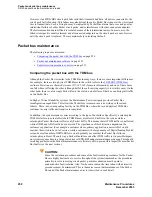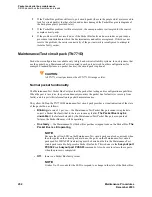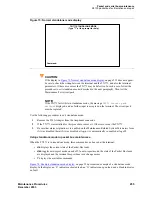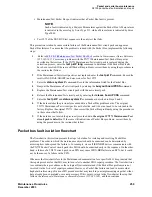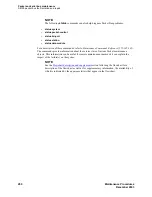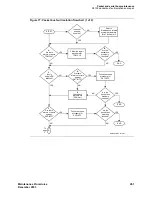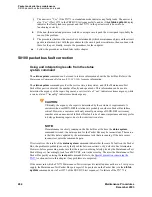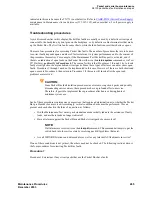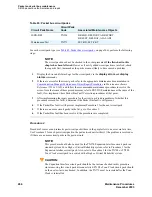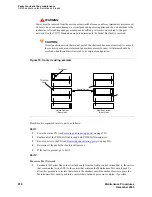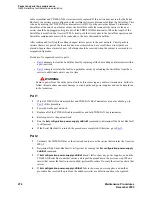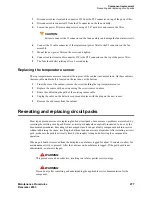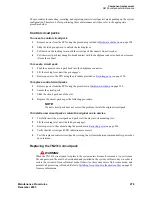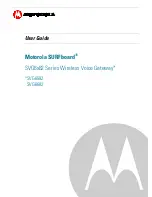
Packet and serial bus maintenance
S8100 packet bus fault isolation and repair
264
Maintenance Procedures
December 2003
j
The answer is ‘‘Yes’’ if the TN771 in standalone mode indicates any faulty leads. The answer is
also ‘‘Yes’’ if Test #572 in the PKT-BUS test sequence fails, and/or if the
status system
display
indicates that faulty leads are present and the TN771 in the port network is known to be
functioning correctly.
k
If the non-functional endpoints are isolated to a single circuit pack, the circuit pack is probably the
cause of the problem.
l
The procedures that must be executed are determined by which maintenance objects on the circuit
packs are alarmed. Start with the procedures for the circuit pack errors/alarms, then continue with
those for the port. Finally, execute the procedures for the endpoint.
m
Follow the procedures outlined later in this chapter.
S8100 packet bus fault correction
Using and interpreting results from the status
system command
The
status system
command can be issued to retrieve information about the Packet Bus. Refer to the
Maintenance Commands Reference (555-245-101) for more information.
The
status system
command provides the service state, alarm status, and (if the Maintenance/Test
Packet Bus port is activated) the number of faulty and open leads. This information can be used to
determine the urgency of the repair. In general, a service state of ‘‘out’’ indicates extreme urgency, while
a service state of ‘‘reconfig’’ indicates moderate urgency.
CAUTION:
Ultimately, the urgency of a repair is determined by the customer’s requirements. A
customer who uses ISDN-BRI for station sets probably considers a Packet Bus failure
critical. However, a customer with only a small percentage of ISDN-BRI service may
consider even an uncorrectable Packet Bus fault to be of minor importance and may prefer
to delay performing repairs, due to their destructive nature.
NOTE:
If maintenance is actively running on the Packet Bus at the time the
status system
command is issued, the data reported for the Packet Bus may be inconsistent. The reason
is that this data is updated by the maintenance tests that are running. If the data seems
inconsistent, enter the command again.
If test results or the results of the
status system
command indicate that there are 24 faults on the Packet
Bus, the problem is probably caused by faulty cables between carriers, or by defective bus terminators.
However, before proceeding, make sure that the report is not being falsely given by the Maintenance/Test
Packet Bus port. Accordingly, look for an M/T-PKT error in the error log. Then test the Maintenance/Test
Packet Bus port by entering the
test port
command. Refer to the
Special precaution concerning the
section earlier in this chapter if any problems are suspected.
If the carrier into which a TN771 Maintenance/Test circuit pack is installed does not have a -5 volt power
supply, the Maintenance/Test Packet Bus port reports 24 open leads on the Packet Bus (via the
status
system
command and via Test #572 of the PKT-BUS test sequence). No failure of the TN771 is
Summary of Contents for CMC1
Page 1: ...Maintenance Procedures 555 245 103 Issue 1 1 December 2003 ...
Page 14: ...Contents 14 Maintenance Procedures December 2003 ...
Page 416: ...Additional maintenance procedures IP Telephones 416 Maintenance Procedures December 2003 ...
Page 426: ...Index X 426 Maintenance Procedures December 2003 ...

